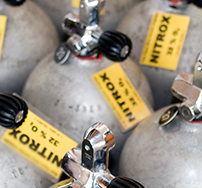Every Little Helps… and sometimes a little help means a whole lot!

SELLING NITROX TO THE DIVERS WHO NEED IT MOST… We should start by saying that subheading contains a misleading statement; every diver needs nitrox. Air is good for pumping up bike tires, but the correct breathing gas for the majority of diving is nitrox or trimix. Of course, there are no absolutes in scuba diving and there are exceptions to every ‘rule.’ For instance, there are spots across the RAID network where nitrox is simply unavailable. If that’s your case, accept our apologies; we do understand that diving without nitrox is better than not diving. By now most dive operations, dive pros, and dive agencies have promoted the advantages of breathing nitrox clear and bold: Reduced Nitrogen Absorption: Because it contains less nitrogen, divers using nitrox can experience less nitrogen buildup in their bodies. This can help decrease the risk of decompression sickness (the bends) on every dive. Extended Bottom Time: Nitrox allows for longer bottom times at certain depths compared to air, making it ideal for dives where extended exploration and adventure is called for. Shorter Surface Intervals: Some dive plans may allow for shorter surface intervals between dives when using nitrox, depending on the specific mix, depth, and number of dives planned for the day. And even a cursory Google search turns up enough five-star ratings to help convince the biggest skeptics. But there’s one advantage to taking a nitrox class that isn’t talked about nearly enough. It’s one that is a real advantage to every diver, but especially the “more experienced” ones had to move placoderms out of the way to get into the water. And oddly it has little to do with the potential health benefits that nitrox may deliver to older divers. NITROX TRAINING IS A FANTASTIC GENERAL REFRESHERTaking a nitrox class reminds divers about some of the basics around dive planning. A good nitrox course (like this RAID specialty) walks the student through some of the simple but critical steps that help to make a dive plan relevant and safe. A nitrox dive tends to have well defined depth and time limits. The planning process for a nitrox dive is also more likely to include working closely with a dive buddy (or buddies) before getting wet. We’re not suggesting that experienced divers tend to have a more ‘ad-hoc’ attitude towards their recreational dive plans, but nitrox training can enhance the diving experience for older divers whose knowledge and safety procedures could use a little nudge in the right direction. Now’s a great time to your experienced diver mailing list with more information about nitrox programs.

